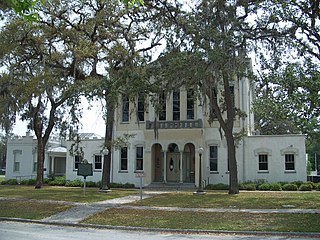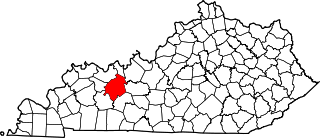
Green Cove Springs is a city in and the county seat of Clay County, Florida, United States. Green Cove Springs is a part of the Jacksonville Metropolitan Area. The population was 9,786 at the 2020 census.

Great Diamond Island is an island in Casco Bay, Maine, United States. It is part of the city of Portland. At the 2000 census, the island had a year-round population of 77. The island is not accessible from the mainland by motor vehicle and has a limited network of roads. The primary modes of transportation are golf carts and bicycles. This fact has become a selling point for the island, marketing the area as "car free" and "kid friendly". The island was used as a military base starting in the late 19th century and continuing through World War II. After the base was decommissioned, the bunkers and residences were left idle for over 30 years before being developed and sold to private citizens.

The Green Cove Springs Historic District is a U.S. historic district located in Green Cove Springs, Florida. The district is bounded by Bay Street, CSX RR tracks, Center Street, Orange Avenue, St. Elmo Street and St. Johns Road. It contains 78 historic buildings and 1 structure.
The Princess Mound is a historic site near Green Cove Springs, Florida. It is located on Fleming Island, northwest of Green Cove Springs. On March 2, 1990, it was added to the U.S. National Register of Historic Places.

The Clay County Historic Courthouse is a historic county courthouse in Green Cove Springs, Florida. The two-story brick building was built in 1889 and used until 1973. A historical marker commemorates its history. It is located at 915 Walnut Street as part of the county's Historic Triangle which includes the Clay County History Museum, Railroad Depot Display, Old County Jail and Archives Center. On June 20, 1975, it was added to the U.S. National Register of Historic Places. It was designed by Ellis and McClure. This historic location is home to Clay County Teen Court programs and is a venue for events such as mock trials, plays, swearing-in ceremonies, photo shoots and tours. The modern, fully operational Clay County Courthouse is a separate facility located at 825 North Orange Avenue in Green Cove Springs. Employees of the Clay County Clerk's Office oversee the operations of both locations' offices.

St. Mary's Episcopal Church is an historic Carpenter Gothic church located at 400 St. Johns Avenue in Green Cove Springs, Florida. On February 17, 1978, it was added to the U.S. National Register of Historic Places.
The Green River Shell Middens Archeological District is a historic district composed of archaeological sites in the U.S. state of Kentucky. All of the district's sites are shell middens along the banks of the Green River that date from the later portion of the Archaic period. Studies of this assemblage of sites were critical in the development of knowledge of the Archaic period in the eastern United States.
The Greenwich Cove Site is a prehistoric archaeological site in Warwick, Rhode Island, US. The site is a significant multi-component site, with finds dating from the Late Archaic to the Middle Woodland Period. It notably includes a shell midden that has only been moderately affected by vandalism and development; these are particularly rare in coastal Rhode Island. The site was added to the National Register of Historic Places in 1980.
The Old Colony Cove Site is an archaeological site near Rose Haven in Anne Arundel County, Maryland. The site consists of a shell midden and is 2,000 feet (610 m) long by 300 feet (91 m) wide.

This is a list of the National Register of Historic Places listings in Henderson County, Kentucky.

This is a list of the National Register of Historic Places listings in Butler County, Kentucky.

This is a list of the National Register of Historic Places listings in Muhlenberg County, Kentucky.

This is a list of the National Register of Historic Places listings in Ohio County, Kentucky.

Historic Spanish Point is a 33-acre (13 ha) museum and environmental complex located in Osprey, Florida at 337 North Tamiami Trail. The museum includes an archeological exhibit of a prehistoric shell mound known as a midden, a turn-of-the-century pioneer homestead historic house museum, a citrus packing house, a chapel, boatyard, gardens, and nature trails.

This is a list of the National Register of Historic Places listings in McLean County, Kentucky.
The Baker Site is an archaeological site in Muhlenberg County, Kentucky, located north of Andrew's Run and 2 miles (3.2 km) northwest of Rochester along the banks of the Green River. The site is a shell midden site dating from the Middle Archaic period. In addition to middens, the site also includes four human graves and three dog graves. A number of artifacts, including projectile points and scrapers, have been obtained from the site.

The Damariscotta Shell Midden Historic District encompasses a significant collection of shell middens along the Damariscotta River in Lincoln County, Maine. It includes eleven middens in all, including the well-known Whaleback Shell Midden and the Glidden Midden, which is the largest shell midden in the northeastern United States. The area has the largest concentration of such midden sites under conservation protection in the eastern United States. The district was listed on the National Register of Historic Places in 1998.
The Coal Village Site, also known as Coal Cove after the name of the bay south of it, is a historic archaeological site near Port Graham, Alaska. It was the location of a coal mining operation established by the Russian American Company in 1855, and was for a time the third largest settlement in Russian Alaska. An open-pit coal mine was mined until 1860, when a fire destroyed the main steam engine, and the site was abandoned in 1865. When the site was listed on the National Register of Historic Places in 1978, it was overgrown, and remnants of building foundations, a railway, and other artifacts were discernible, as was a refuse midden.
The Smuggler Cove Shell Midden is an archeological site located in Oswald West State Park near Neahkahnie Beach, Oregon, United States. First documented by archeologists in 1976, the midden has been found to contain remains of mussels, barnacles, and chiton to a depth of approximately 30 centimeters (12 in). Radiocarbon dating of a single sample of shell debris indicates that the Smuggler Cove campsite was occupied around 1660 CE, approximately the same date as the supposed wreck of a European ship at nearby Nehalem Spit, suggesting the site may preserve information from both before and after first contact between local people and Europeans. The site has been heavily damaged by construction of recreational facilities and coastal erosion, but a significant portion remains with potential to contribute to future research. Data generated from the site may help answer questions related to environmental change in the Oregon Coast region, settlement and subsistence patterns, emergence of ethnographic patterns among coastal people, the change in cultural patterns from before to after contact with European Americans, and other topics.














